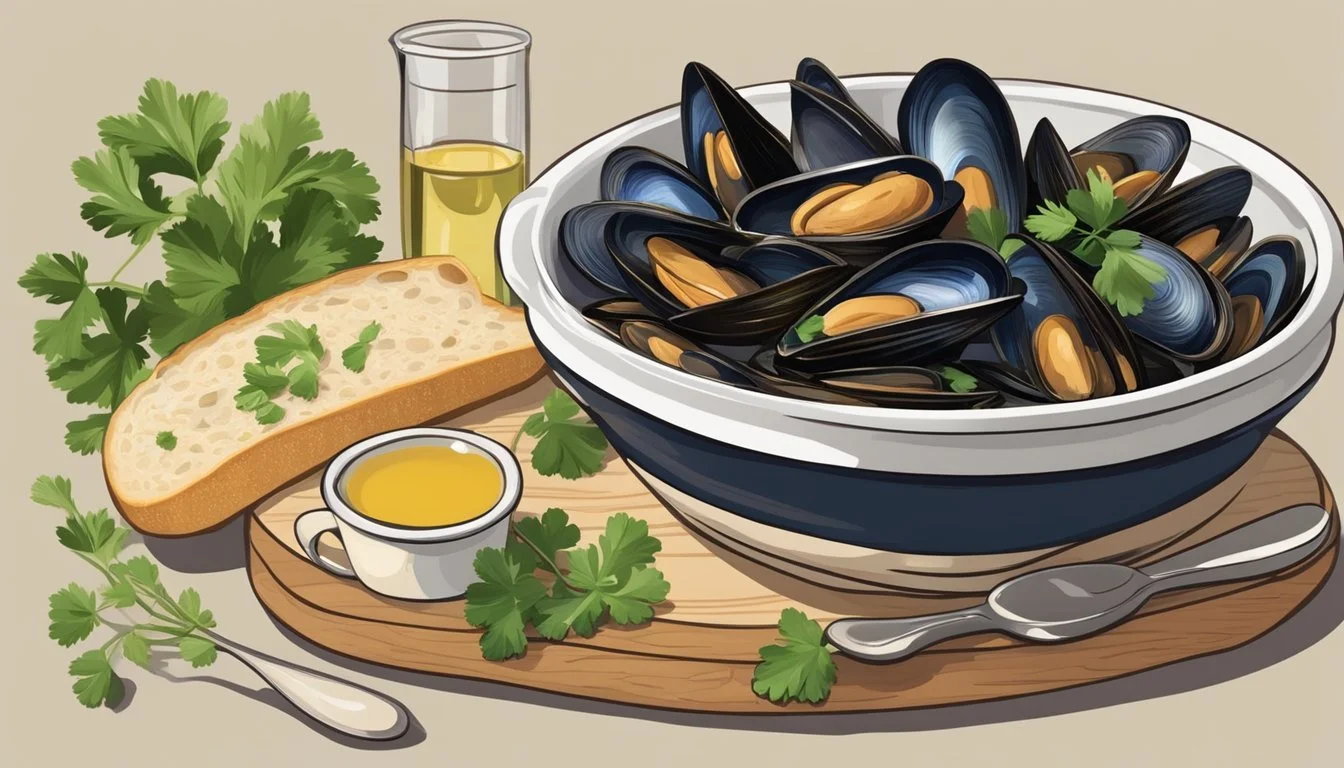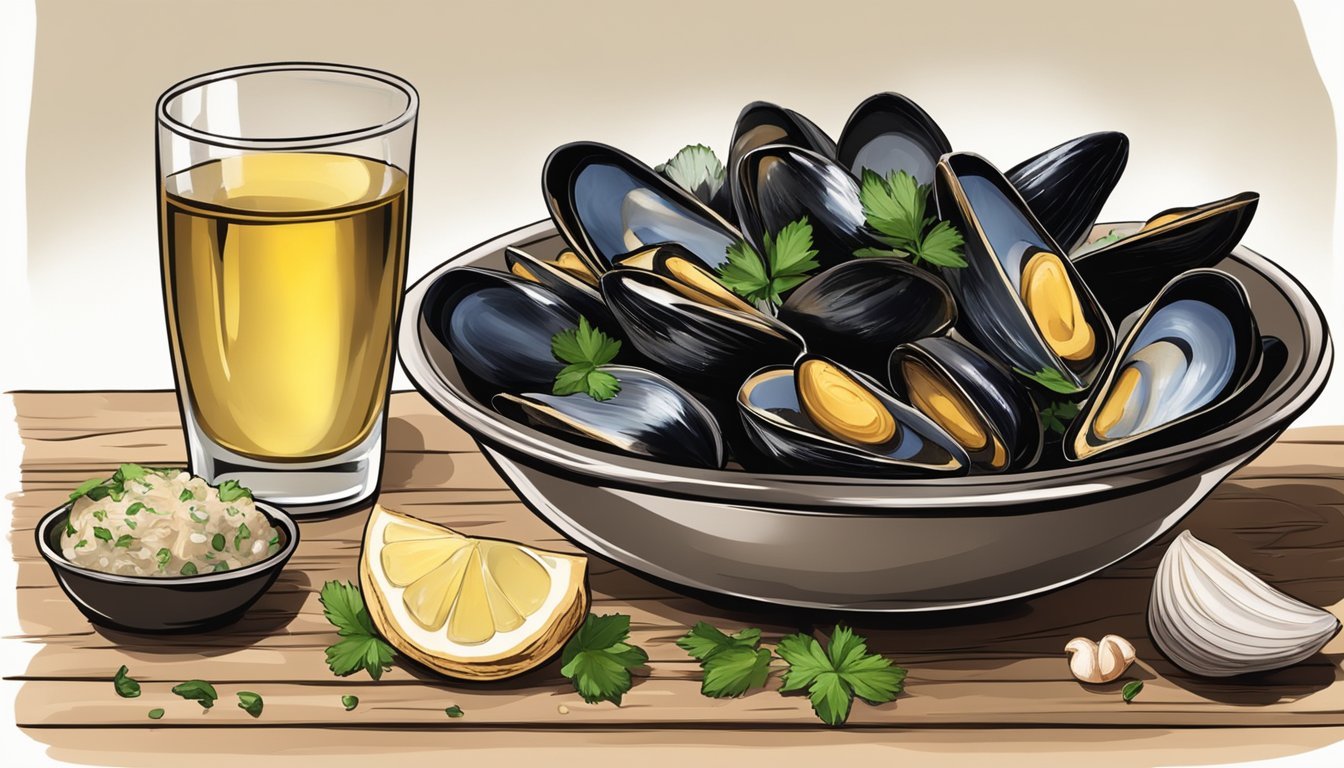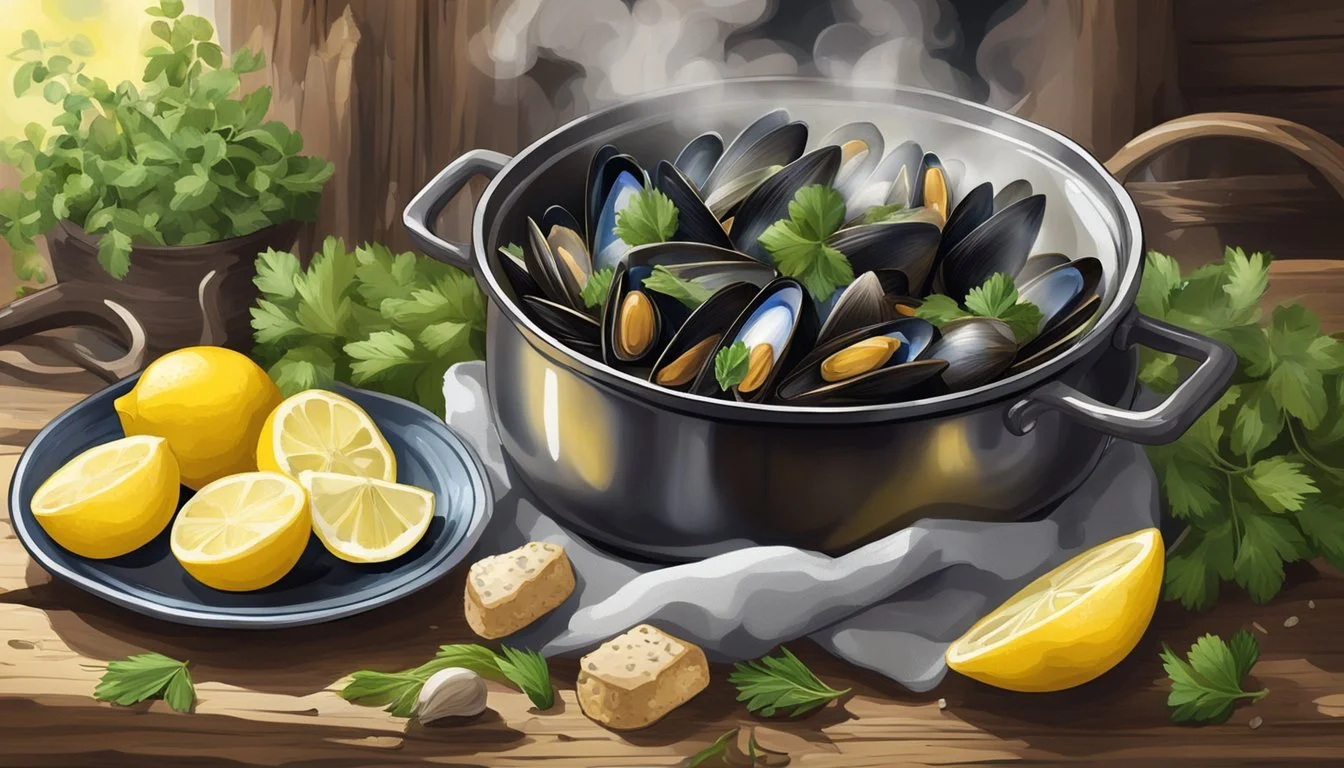How Do You Eat a Moules Marinière?
Mastering the Art of Enjoying Seafood Classics
Moules marinière is a classic French dish that combines the delicate flavors of fresh mussels (What wine goes well with mussels?) with a simple yet aromatic broth of white wine, garlic, shallots, and herbs. This dish is typically enjoyed along the coastal regions of France, where mussels are harvested, and boasts a rich culinary history that is both rustic and refined. It is a staple in French cuisine, celebrated for its simplicity and the way it highlights the natural taste of the seafood (What wine goes well with seafood?).
Eating moules marinière is an experience that goes beyond mere taste. It involves a hands-on approach that is often shared among diners, creating an interactive meal that is as much about the company as it is about the food. The diners typically use an empty mussel shell to pinch and pull the succulent meat from other shells, savoring the taste alongside the infused broth. This traditional technique not only enhances the enjoyment of the dish but also reflects the informal and convivial spirit associated with French coastal dining.
Ingredients and Preparation
Crafting a savory moules marinière begins with gathering quality ingredients and preparing the mussels properly to ensure the best flavor and texture.
Essential Ingredients
For a classic moules marinière, one needs the following basic ingredients:
Mussels: Typically, 2 pounds (about 900g) serves two people.
White Wine: About 1 cup, dry varieties preferred for their crisp acidity.
Shallots: 2-3, finely diced.
Garlic: 2 cloves, minced.
Butter: Usually starting with a tablespoon.
Parsley: Fresh, for garnish, chopped finely.
Choosing the Right Mussels
When selecting mussels, freshness is the key. They should be:
Live Mussels: Make sure they are alive; they should close when tapped.
Intact Shells: Discard any with broken shells.
Cleaned and Debearded: Live mussels often come cleaned, but one must check for beards (the fibrous tuft) and barnacles, which can be removed by scrubbing under cold running water.
Preparation Tips
Preparing moules marinière at home requires simple steps:
Soaking: Soak the mussels in cold water with a bit of salt to remove any residual grit.
Pre-Cleaning: Inspect each mussel; mussels that remain open should be discarded, as they are likely dead and unsafe to eat.
Cooking Base: In a large pot, melt butter and cook shallots, garlic, and some bay leaves until soft but not browned, seasoning lightly with salt and heavily with black pepper.
Steaming Mussels: Add the prepared mussels and white wine, cover, and steam until the mussels have opened, discarding any that do not open after cooking.
Serving: Serve hot, garnished with chopped parsley for a fresh, herby finish.
Cooking Instructions
Moules marinière, a classic French dish, involves steaming mussels in a flavorful white wine sauce. The cooking process is straightforward and yields a rich broth that complements the tender mussels.
Cooking Process
To begin, one must clean and debeard the mussels, discarding any that remain open when gently tapped. Using a large pot on medium heat, the mussels are cooked with a combination of herbs such as thyme and bay leaves. They should be carefully steamed under a lid until they just open, indicating they are cooked through.
Making the Sauce
While the mussels steam, a sauce is prepared in a separate pot. Start by gently frying aromatics like shallots and garlic in butter and olive oil until they are translucent. The cooking liquid is typically a combination of white wine and broth, brought to a simmer to blend the flavors. Lemon juice may be added for a hint of acidity.
Final Touches
After the mussels have opened, they are removed with tongs, and the cooking liquid is usually combined with the white wine mixture to create a smooth sauce. Heavy cream is optional for a richer texture. The dish is finished by stirring in chopped parsley for a fresh element. The sauce should be poured over the mussels just before serving, ensuring a harmonious blend of flavors.
Serving and Presentation
Moules marinières, traditionally a main course, dazzles as both an appetizer or the star of the meal. The dish's allure hinges on its maritime essence and rustic simplicity, coming to life with the correct serving and presentation techniques.
Dishing Out
The preferred vessel for moules marinières is a large pot or a Dutch oven, which moves seamlessly from the stove to the table. When the mussels have been cooked, they should open, signaling they're ready to be served. One should ensure the broth—flavored by the mussels' natural juices and added ingredients like garlic, wine, and herbs—is well incorporated.
Accompaniments
Bread: A side of crusty bread or a French baguette is essential, perfect for soaking up the savory broth.
Side Dishes: Commonly, French fries are served alongside, often referred to as 'moules-frites' when paired.
The choice of accompaniment may influence whether the dish is enjoyed as an appetizer or the main course. Bread accentuates the mussels for a lighter fare, while fries lend a more substantial, meal-worthy combination.
Eating Etiquette
Mussels may be eaten with a fork or directly with the hands, which is often considered part of the authentic experience. If using hands, it's customary to:
Select a shell as tongs to pluck the mussel meat from other shells.
A finger bowl should be provided for each diner to clean their fingers after handling the mussels.
The broth is savored by tilting the shell or using a spoon, and any remaining liquid in the pot is traditionally enjoyed by dipping bread into it. The convivial spirit of the meal encourages sharing and a casual, hands-on dining experience.
Variations of Moules Marinière
Moules Marinière, a classic French dish, enjoys numerous regional and ingredient variations, each offering a distinctive taste profile. Whether influenced by local culinary traditions or a creative twist on the original, these variations showcase the versatility of French mussels in cuisine.
Regional Twists
Normandy: In Normandy, the proximity to apple orchards means that chefs often swap the traditional dry white wine for dry cider, complementing the mussels with a subtle fruity undertone.
Belgium: North of France, Belgian variations may incorporate beer instead of wine, infusing the mussels with a rich, malty flavor that is unique to the region's brewing heritage.
Alternative Ingredients
Moules à la Crème: This variation includes the addition of double cream or heavy cream to the cooking liquid, creating a richer, more indulgent sauce.
Moules au Roquefort: Another indulgent alternative incorporates Roquefort cheese, melting it into the sauce for a tangy, creamy twist that is both bold and sophisticated.
Cooking Fats: While some chefs use unsalted butter, others may opt for salted butter or even olive oil as the cooking fat, which subtly alters the flavor of the sauce accompanying the mussels.
Additional Flavors:
Coriander, bacon, or coconut milk can be used to add depth, with coriander offering a citrusy note, bacon a smoky saltiness, and coconut milk lending a tropical creaminess to the dish.
Health and Dietary Considerations
When indulging in moules marinière, diners should be mindful of their personal dietary needs and restrictions. The dish’s ingredients can influence calorie count, allergenic potential, and its fit within various diet plans.
Allergies and Intolerances
Moules marinière contains mussels, which are a type of shellfish. (What wine goes well with shellfish?) Shellfish are a common allergen that can cause reactions in individuals with a shellfish allergy. Symptoms can range from mild hives to severe anaphylaxis. Therefore, those with seafood allergies should avoid this dish. Additionally, because the classic recipe includes butter, it is not suitable for individuals who are dairy-free unless a substitution is made.
Caloric Information
The caloric content of moules marinière can vary depending on the recipe; however, it is generally considered nutritious given the health benefits of mussels. They are an excellent source of protein and omega-3 fatty acids, which are beneficial for heart health. A typical serving without any additional sides or dipping bread hovers around 200-400 calories.
Dietary Substitutions
For diners adhering to gluten-free diets, moules marinière can easily comply as long as it is prepared without ingredients that contain gluten. To cater to a dairy-free diet, one can substitute butter with olive oil or another dairy-free alternative. Those looking for a healthier version can limit the amount of butter or oil to reduce fat content or substitute cream with a lighter broth.
Pairings and Beverages
When serving moules marinière, selecting the right beverage enhances the overall experience. Traditionally, a glass of white wine is the go-to choice. Specifically, a dry white wine like Muscadet complements the dish's flavors without overpowering them. This selection mirrors the wine used in cooking, creating a harmonious taste experience.
For those preferring a different type of wine, a Pinot Noir Rosé can be a pleasant alternative. Its vibrant acidity and red berry aromatics offer a refreshing counterbalance to the rich seafood flavors.
In the realm of beer, one might choose a light, crisp variety. The effervescence and subtle hop notes cut through the dish’s creaminess, cleansing the palate between bites.
Accompanying the moules with a sprinkle of fresh herbs (how long do fresh herbs last?) boosts the dish’s aromatic quality. Flat-leaf parsley is a favorite choice for its fresh, clean flavor which does not overwhelm the delicate taste of the mussels. The green notes of the parsley resonate particularly well with the crispness of the selected beverages.
Recommended Beverage Pairings
White Wine:
Muscadet (classic choice)
Dry Riesling (aromatic alternative)
Rosé:
Pinot Noir Rosé (fruity option)
Beer:
Light Lager or Pilsner (crisp and refreshing)
Incorporating fresh herbs like flat-leaf parsley harmonizes with the beverage selection, allowing for a truly balanced culinary experience.
Tips for Cooking at Home
When preparing moules marinière at home, one should consider it not only a recipe but an experience. This French dish, comprised of mussels in a white wine sauce, can be both fun to make and a delightful light lunch. The process is easy to cook, and by following these guidelines, anyone can bring a taste of France into their kitchen.
First, selecting fresh mussels is crucial. They should be alive, closed, or close when tapped. If any mussels remain open, discard them as they are not safe to eat. Rinse and debeard the mussels before cooking.
In terms of equipment, one will need a large pot or Dutch oven. Begin by sautéing aromatics like shallots and garlic in butter, being careful not to brown them. This provides a foundation of flavor for the dish. A good rule to follow is:
Sauté shallots and garlic for approximately 10 minutes.
Add a generous amount of white wine to the pot.
When the wine simmers, add the mussels and cover the pot, allowing them to steam. They're ready when they've opened, generally in about 3-5 minutes. Remember to discard any mussels that haven't opened after cooking.
For those who enjoy creamier sauces, one can remove the cooked mussels, keeping them warm, and then return the pot to the heat. Adding double cream to the cooking liquid and boiling for a few extra minutes can create a richer sauce. Just before serving, mix in freshly chopped parsley for a touch of brightness.
Lastly, mussel eating etiquette is straightforward. Use an empty shell as makeshift tongs to pluck the mussels from their opened shells. This technique adds an interactive element to the dining experience and keeps things clean.
Selecting Seafood at the Market
When visiting a fishmonger for live mussels, the proximity to the ocean can often be a positive indicator of freshness. Buyers should look for fishmongers that maintain a consistently cool and clean environment, as this helps ensure the mussels are fresh from the ocean and less likely to spoil.
Live Mussels: Mussels should be alive when purchased. This is evident if they are closed or close when gently tapped. If one encounters open mussels that do not close upon tapping, they should be discarded, as they are likely no longer viable for cooking.
Freshness Signs:
Shells: Look for mussels with intact, unbroken shells; cracks or holes may mean they are compromised.
Smell: Fresh mussels should have a briny scent, reminiscent of the ocean. Any strong, off-putting smells are indicators they should not be consumed.
When selecting mussels:
Inspect the shell for signs of damage.
Smell the mussels for the fresh sea scent.
Tap any open mussels and observe if they close.
Buyers are encouraged to interact with their fishmongers, inquiring about the origin and best handling practices for their selected seafood. Knowledgeable fishmongers are typically eager to share storage tips, ensuring one's mussels stay fresh until ready to be prepared in dishes such as moules marinière.
Storage and Freshness
When purchasing mussels for making moules marinière, consumers should ensure freshness above all. Fresh mussels should be stored in the fridge, ideally in a bowl covered with a wet cloth, and should be cooked within two days of purchase. Mussels are best when they are at their freshest, displaying tightly closed shells or slightly opening when tapped but closing promptly, indicating they are alive and safe to eat.
Inspecting Freshness: Fresh mussels will have a sea-fresh aroma and moist shells. A fishy smell is a red flag, signaling that the mussels may be spoiling. Mussels with broken shells or those that are significantly open and do not close when lightly tapped should be discarded.
Before Cooking:
Rinse mussels under cold running water.
Scrub the shells with a brush to remove debris.
Pull off the "beards" – the fibrous tufts sticking out from the shell.
Note: If any mussels remain open during this process and do not close when tapped, discard them as they're likely no longer fresh.
After Cooking:
Properly cooked mussels should open up, confirming their edibility.
If some mussels remain closed after cooking, it's advised to discard them as well.
Overcooking mussels can lead to a rubbery texture, while undercooking can keep them hard. It is crucial to balance the cooking time to maintain the delicate texture of the meat.
Following these guidelines will help ensure that moules marinière is made with the highest quality and freshest mussels, providing a safe and enjoyable dining experience.
Cultural Significance
Moules marinière is a quintessential French dish that embodies the country's culinary heritage. This traditional seafood meal has its roots firmly planted in Normandy and Brittany, where the abundant coastal waters provide the ideal environment for mussel farming. It's not just a dish, but a cultural symbol that unites people around the French notion of bon appétit—the joy of eating well.
In France, moules marinière represents more than just sustenance; they are often associated with convivial gatherings and leisurely dining, illustrating the importance of social interaction in French dining culture. The straightforward method of eating the dish—using an empty mussel shell to pick up others—highlights a casual yet intimate approach, enhancing the shared dining experience.
Across the border in Belgium, this mussel dish is equally revered. Often served with frites, it forms a staple in Belgian cuisine and reflects the shared culinary traditions with its neighbor.
Restaurants across both countries feature moules marinière on their menus, which speaks to its enduring popularity and significance. While local variations exist, chefs honor the timeless simplicity that defines this classic. The act of preparing and savoring moules marinière is a gesture of respect towards regional produce and ancestral methods, carrying on generations' worth of culinary knowledge and appreciation for high-quality, locally-sourced ingredients.
In summary, moules marinière is not merely food; it's a bridge connecting diners to the coastal heritage of France and Belgium and a testament to the value placed on communal dining and culinary tradition.







